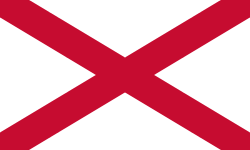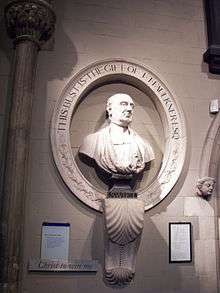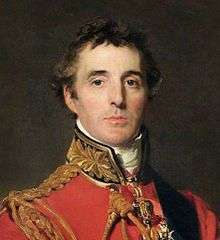Anglo-Irish people
 St Patrick's Cross is often seen as a symbol of the Anglo-Irish | |
| Regions with significant populations | |
|---|---|
| Ireland | |
| Languages | |
| Standard English, Hiberno-English, Irish | |
| Religion | |
|
Anglicanism (see also Religion in Ireland) | |
| Related ethnic groups | |
| English, Irish, Ulster Scots, Welsh, Scots |
Anglo-Irish (Irish: Angla-Éireannach) was a term used primarily in the 19th and early 20th centuries to identify a privileged social class in Ireland, whose members were mostly the descendants and successors of the Protestant Ascendancy.[1] They mostly belonged to the Anglican Church of Ireland, which was the established church of Ireland until 1871, or to a lesser extent one of the English dissenting churches, such as the Methodist church. Its members tended to follow English practices in matters of culture, science, law, agriculture and politics. Many became eminent as administrators in the British Empire and as senior army and naval officers.
The term is not usually applied to Presbyterians in the province of Ulster, whose ancestry is mostly Scottish, rather than English or Irish, and who are sometimes identified as "Ulster-Scots". While many of the Anglo-Irish were part of the English diaspora in Ireland, some were of Irish Catholic origin but had converted to Anglicanism.[2]
Anglo-Irish social class
The term "Anglo-Irish" is often applied to the members of the Church of Ireland who made up the professional and landed class in Ireland from the 17th century up to the time of Irish independence in the early 20th century. In the course of the 17th century, this Anglo-Irish landed class replaced the Gaelic Irish and Old English aristocracies as the ruling class in Ireland. They were also referred to as "New English" to distinguish them from the "Old English" who descended from the medieval Hiberno-Norman settlers. A larger but less socially prominent element of the Protestant Irish population were the immigrant French Huguenots and the English and Scottish dissenters who settled in Ireland in the 17th and 18th centuries, many of whom later emigrated to the American colonies.
Under the Penal Laws, which were in force between the 17th and 19th centuries (although enforced with varying degrees of severity), Roman Catholic recusants in Great Britain and Ireland were barred from holding public office, while in Ireland they were also barred from entry to the University of Dublin and from professions such as law, medicine, and the military. The lands of the recusant Roman Catholic landed gentry who refused to take the prescribed oaths were largely confiscated during the Plantations of Ireland, and the rights of Roman Catholics to inherit landed property were severely restricted. Those who converted to the Church of Ireland were usually able to keep or regain their lost property, as the issue was primarily one of allegiance. In the late 18th century the Parliament of Ireland in Dublin won legislative independence, and the movement for the repeal of the Test Acts began.

The Anglo-Irish social class was usually of mixed English and Irish or Welsh ancestry.[2] Members of this ruling class commonly identified themselves as Irish,[3] while retaining English habits in politics, commerce, and culture. They participated in the popular English sports of the day, particularly racing and fox hunting, and intermarried with the ruling classes in Great Britain. Many of the more successful of them spent much of their careers either in Great Britain or in some part of the British Empire. Many constructed large country houses, which became known in Ireland as Big Houses, and these became symbolic of the class' dominance in Irish society.
The Dublin working class playwright Brendan Behan, a staunch Irish Republican, saw the Anglo-Irish as Ireland's leisure class and famously defined an Anglo-Irishman as "a Protestant with a horse".[4]
The Anglo-Irish novelist and short story writer Elizabeth Bowen memorably described her experience as feeling "English in Ireland, Irish in England" and not accepted fully as belonging to either.[5]
Due to their prominence in the military and their conservative politics, the Anglo-Irish have been compared to the Prussian Junker class by, among others, Correlli Barnett.[6]
Business interests
At the beginning of the 20th century, the Anglo-Irish owned many of the major indigenous businesses in Ireland, such as Jacob's Biscuits, Bewley's, Beamish and Crawford, Jameson's Whiskey, W. P. & R. Odlum, Cleeve's, R&H Hall, Maguire & Patterson, Dockrell's, Arnott's, Goulding Chemicals, the Irish Times, the Irish Railways, and the Guinness brewery, Ireland's largest employer. They also controlled financial companies such as the Bank of Ireland and Goodbody Stockbrokers.
.jpg)
Prominent members
Prominent Anglo-Irish poets, writers, and playwrights include Jonathan Swift, George Berkeley, Oliver Goldsmith, Bram Stoker, Oscar Wilde, J. M. Synge, W. B. Yeats, Cecil Day-Lewis, Bernard Shaw, Augusta, Lady Gregory, Samuel Beckett, Giles Cooper, C. S. Lewis, Lord Longford and Elizabeth Bowen.
In the 19th century, some of the most prominent scientists of the British Isles, including Sir William Rowan Hamilton, George Gabriel Stokes, and John Tyndall, George Johnstone Stoney, Thomas Romney Robinson, Edward Sabine, Thomas Andrews, The 3rd Earl of Rosse, George Salmon, George FitzGerald, were Anglo-Irish, and in the 20th century John Joly and Ernest Walton shared this identity. The polar explorer Sir Ernest Shackleton was also an Anglo-Irishman.
Medical experts included Sir William Wilde, Robert Graves, Thomas Wrigley Grimshaw, William Stokes, Robert Collis, Sir John Lumsden and William Babington.
The Anglo-Irishmen Edmund Burke, Richard Brinsley Sheridan, Henry Grattan, Viscount Castlereagh, George Canning, The 1st Earl Macartney, Thomas Spring Rice, Charles Stewart Parnell, and The 1st Baron Carson played major roles in British politics.
The Anglo-Irish were also represented among the senior officers of the British Army by men such as Field Marshal The 1st Earl Roberts, first honorary Colonel of the Irish Guards regiment, who spent most of his career in British India; Field Marshal The 1st Viscount Gough, who served under Wellington, himself a Wesley born in Dublin to The 1st Earl of Mornington, head of a prominent Anglo-Irish family in Dublin; and in the 20th century Field Marshal The 1st Viscount Alanbrooke, Field Marshal The 1st Earl Alexander of Tunis, Field Marshal Sir Henry Wilson and Field Marshal The 1st Viscount Wolseley. (see also Irish military diaspora).
Prolific art music composers included Michael William Balfe, John Field, George Alexander Osborne, Thomas Roseingrave, Charles Villiers Stanford, John Andrew Stevenson, Robert Prescott Stewart, William Vincent Wallace, and Charles Wood.
In the visual arts the sculptor John Henry Foley, art dealer Hugh Lane, the artists Daniel Maclise, William Orpen and Jack Yeats, the ballerina Dame Ninette de Valois and the designer-architect Eileen Gray were famous outside Ireland.
William Desmond Taylor was an early and prolific maker of silent films in Hollywood.
Philanthropists included Thomas Barnardo and The 1st Earl of Iveagh.
Discussing the lack of Irish civic morality in 2011, former Taoiseach Garret FitzGerald remarked that before 1922: "In Ireland a strong civic sense did exist – but mainly amongst Protestants and especially Anglicans".[7]
Attitude towards Irish independence
The Anglo-Irish, as a class, were mostly opposed to the notions of Irish independence and Home Rule.[8] Most were supporters of continued political union with Great Britain, which existed between 1800 and 1922. This was for many reasons, but most important were the economic benefits of union for the landowning class, the close personal and familial relations with the British establishment, and the political prominence held by the Anglo-Irish in Ireland under the union settlement.[9] Many Anglo-Irish men served as officers in the British Army, were clergymen in the established Anglican Church of Ireland or had land (or business interests) across the British Isles – all factors which encouraged political support for unionism. Between the mid-nineteenth century and 1922, the Anglo-Irish comprised the bulk of the support for movements such as the Irish Unionist Alliance, especially in the southern three provinces of Ireland.[10]
However, Protestants in Ireland, and the Anglo-Irish class in particular, were by no means universally attached to the cause of continued political union with Great Britain. For instance, author Jonathan Swift (1667–1745), a clergyman in the Church of Ireland, vigorously denounced the plight of ordinary Irish people under British rule. Reformist politicians such as Henry Grattan (1746–1820), Wolfe Tone (1763–1798), Robert Emmet (1778–1803), Sir John Gray (1815-1875), and Charles Stewart Parnell (1846–1891), were also Protestant nationalists, and in large measure led and defined Irish nationalism. The Irish Rebellion of 1798 was led by members of the Anglo-Irish and Ulster Scots class, some of whom feared the political implications of the impending union with Great Britain.[11] By the late 19th and early 20th centuries, however, Irish nationalism became increasingly tied to a Roman Catholic identity.[11] By the beginning of the twentieth century, many Anglo-Irishmen in southern Ireland had become convinced of the need for a political settlement with Irish nationalists. Anglo-Irish politicians such as Sir Horace Plunkett and Lord Monteagle became leading figures in finding a peaceful solution to the 'Irish question'.
During the Irish War of Independence (1919–1921), many Anglo-Irish landlords left the country due to attacks on their family homes.[12] Animosity towards them continued after the establishment of the Irish Free State in 1922. Many members of the Anglo-Irish class subsequently left Ireland forever, fearing that they would be subject to discriminatory legislation and social pressures. The Anglo-Irish proportion of the Irish population dropped from 10% to 6% in the twenty-five years following independence,[13] with most resettling elsewhere in the British Isles.
The reaction of the Anglo-Irish to the Anglo-Irish Treaty which envisaged the establishment of the Irish Free State was mixed. J. A. F. Gregg, the Church of Ireland Archbishop of Dublin, stated in a sermon in December 1921 (the month the Treaty was signed):
It concerns us all to offer the Irish Free State our loyalty. I believe there is a genuine desire on the part of those who have long differed from us politically to welcome our co-operation. We should be wrong politically and religiously to reject such advances.[14]
In 1925, when the Irish Free State was poised to outlaw divorce, the poet W. B. Yeats delivered a famous eulogy on the Anglo-Irish in the Free State's Senate:
I think it is tragic that within three years of this country gaining its independence we should be discussing a measure which a minority of this nation considers to be grossly oppressive. I am proud to consider myself a typical man of that minority. We against whom you have done this thing, are no petty people. We are one of the great stocks of Europe. We are the people of Burke; we are the people of Grattan; we are the people of Swift, the people of Emmet, the people of Parnell. We have created the most of the modern literature of this country. We have created the best of its political intelligence. Yet I do not altogether regret what has happened. I shall be able to find out, if not I, my children will be able to find out whether we have lost our stamina or not. You have defined our position and have given us a popular following. If we have not lost our stamina then your victory will be brief, and your defeat final, and when it comes this nation may be transformed.[15]
The term "Anglo-Irish" is no longer commonly used to describe southern Irish Protestants, or Protestant citizens of the Republic of Ireland as a group, since —despite retaining a certain distinctive identity— they have mostly been keen to stress their Irishness and loyalty to the Republic of Ireland.
Anglo-Irish peers
Following the English victory in the Nine Years' War (1594–1603), the "Flight of the Earls" in 1607, the traditional Gaelic Irish nobility was displaced in Ireland, particularly in the Cromwellian period. By 1707, after further defeat in the Williamite War and the subsequent Union of England and Scotland, the aristocracy in Ireland was dominated by Anglican families who owed allegiance to the Crown. Some of these were Irish families who had chosen to conform to the established Church of Ireland, keeping their lands and privileges, such as the Dukes of Leinster (whose surname is FitzGerald, and who descend from the Old English aristocracy), or the Gaelic Guinness family. Some were families of British or mixed-British ancestry who owed their status in Ireland to the Crown, such as the Earls of Cork (whose surname is Boyle and whose ancestral roots were in Herefordshire, England).
Among the prominent Anglo-Irish peers are:

- The 1st Earl of Cork, Lord High Treasurer of Ireland, father of scientist Robert Boyle.
- The 1st Baron Glenavy, second-last Lord Chancellor of Ireland and first Cathoirleach (or Chairman) of the Irish Senate (1922).
- The 8th Marquess Conyngham, owner of the Slane Castle rock venue and candidate for Fine Gael in recent Irish general elections.
- The 3rd Earl of Iveagh, of Gaelic Irish descent; head of the Guinness family who sat in the Irish Senate (1973–1977).
- Valerie, Lady Goulding, founder of the Rehabilitation Institute and close associate of former Taoiseach (Prime Minister) Charles Haughey.
- The 6th Earl of Longford, Impresario at the Gate Theatre in Dublin in the 1950s.
- The 7th Earl of Longford (who succeeded his brother (above) in the Earldom), British Labour Cabinet minister, biographer and friend of Éamon de Valera.
- The 3rd Earl of Rosse, astronomer and builder of the then-largest telescope in the world.
- The 18th Baron of Dunsany, author.
- The 1st Duke of Ormonde, 17th century statesman, served as Lord Deputy of Ireland on two occasions and commanded Royalist forces in Ireland in the Irish Confederate Wars negotiating with the Irish Confederates on behalf of Charles I.
- Murrough, 1st Earl of Inchiquin, 6th Baron Inchiquin (1618–1674), of Gaelic Irish descent; a Parliamentary commander in the Irish Confederate Wars 1644-48 before changing sides to become one of the leaders of the Royalist troops in Ireland during the Wars of the Three Kingdoms and the Cromwellian conquest of Ireland (1649–53).
- Field Marshal The 1st Duke of Wellington, Irish-born British general who fought many successful campaigns and defeated Napoleon at the Battle of Waterloo. He later became Prime Minister of the United Kingdom of Great Britain and Ireland.
Until the year 1800, the peers of Ireland were all entitled to a seat in the Irish House of Lords, the upper house of the Parliament of Ireland, in Dublin. After 1800, under the provisions of the Act of Union, the Parliament of Ireland was abolished and the Irish peers were entitled to elect twenty-eight of their number to sit in the British House of Lords, in London, as representative peers. During the Georgian Era, titles in the peerage of Ireland were often granted by the British monarch to Englishmen with little or no connection to Ireland, as a way of preventing such honours from inflating the membership of the British House of Lords.[16]
A number of Anglo-Irish peers have been appointed by Presidents of Ireland to serve on their advisory Council of State. Some were also considered possible candidates for presidents of Ireland, including:
- Valerie, Lady Goulding
- Lord Killanin
- Lord Ashbourne (a renowned Gaelic scholar).
See also
- Baron Baltimore
- Protestant Irish nationalists
- Derry
- Hiberno-English
- Ireland–United Kingdom relations
- Irish Unionist Alliance
- Irish migration to Great Britain
- Miler Magrath
- Reform Movement
- Samuel Beckett
- Unionism in Ireland
- West Brit
References
- ↑ The Anglo-Irish, Fidelma Maguire, University College Cork Archived 2 May 2006 at the Wayback Machine. and Donnchadh Ó Corráin
- 1 2 Wolff, Ellen M. (2006). An Anarchy in the Mind and in the Heart: Narrating Anglo-Ireland. Lewisburg: Bucknell University Press. p. 37. ISBN 0838755569.
- ↑ The Anglo-Irish, Movements for Political & Social Reform, 1870–1914, Multitext Projects in Irish History, University College Cork Archived 2 May 2006 at the Wayback Machine.
- ↑
Pat: He was an Anglo-Irishman.
Meg: In the name of God, what's that?
Pat: A Protestant with a horse.
Ropeen: Leadbetter.
Pat: No, no, an ordinary Protestant like Leadbetter, the plumber in the back parlour next door, won't do, nor a Belfast orangeman, not if he was as black as your boot.
Meg: Why not?
Pat: Because they work. An Anglo-Irishman only works at riding horses, drinking whiskey, and reading double-meaning books in Irish at Trinity College.— From act one of The Hostage, 1958 - ↑ Paul Poplowski, "Elizabeth Bowen (1899-1973)," Encyclopedia of Literary Modernism, (Westport, Connecticut: Greenwood Press, 2003), pp. 26–28. ISBN 0-313-31017-3
- ↑ "Roberts, Kitchener and Wolesley were three national heroes of the nineteenth century whom Correlli Barnett sees as prime examples of the Anglo-Irish gentry, "the nearest thing Britain ever possessed to the Prussian Junker class". Desmond and Jean Bowen, Heroic Option: the Irish in the British Army, Pen & Sword, Barnsley, 2005.
- ↑ "Ireland's lack of civic morality grounded in our history", Irish Times, 9 April 2011, p.14
- ↑ Alan O'Day, Reactions to Irish Nationalism, 1865–1914 (Bloomsbury Publishing, 1 Jul 1987), 376.
- ↑ D. George Boyce, Nationalism in Ireland (Routledge, 2 Sep 2003), 40.
- ↑ Alan O'Day, Reactions to Irish Nationalism, 1865–1914 (Bloomsbury Publishing, 1 Jul 1987), 384.
- 1 2 D. George Boyce, Nationalism in Ireland (Routledge, 2 Sep 2003), 309.
- ↑ http://www.reform.org/TheReformMovement_files/article_files/articles/cork.htm
- ↑ The Anglo-Irish Archived 2 May 2006 at the Wayback Machine., Fidelma Maguire, University College of Cork
- ↑ Ashburton Guardian, Volume XLII, Issue 9410, 14 December 1921, Page 5
- ↑ Seanad Debates, 11 June 1925
- ↑ Simon Winchester, Their Noble Lordships: Class and Power in Modern Britain, (New York: Random House, 1984), p. 202, ISBN 0-394-52418-7.
Bibliography
- Killeen, Jarlath (2005). Gothic Ireland: Horror and the Irish Anglican Imagination in the Long Eighteenth Century. 1851829431. ISBN 0140154094.